#jttw friar sand
Explore tagged Tumblr posts
Text
The Red Boy fight is something else

One of the first times on this journey where Wukong gets his ass kicked.
Side note, his brothers care about him and heal him with massages and their magic hands in the book, and it's wholesome.
17 notes
·
View notes
Text

Wukong being in a decapitation contest and being excited for it is crazy😭 he even said “it was fun”
I like whenever we see different sides of Wukong, such as being anxious whenever his severed head didn’t come back to his body, which caused him to grow another head lol.
Wukong then acting like he didn’t almost die and shows off to an astonished Bajie that he doesn’t even have a scar from the sword 😭💀
31 notes
·
View notes
Note
Is there an English translation of JttW that you consider definitive, or just personally recommend over others? Sorry if you've been asked this a million times!
See my previous answer.
I have numerous foreign language translations of the novel available here.
#Sun Wukong#Monkey King#Journey to the West#Journey to the West translation#JTTW#Lego Monkie Kid#Anthony C. Yu#W. J. F. Jenner#translation#Tripitaka#Tang Monk#Tang Sanzang#Zhu Bajie#Zhu Wuneng#Pigsy#Sha Wujing#Sha Monk#Friar Sand
43 notes
·
View notes
Text
YES. JOURNEY TO THE WEST IS INCREDIBLE.
I got a 4-volume set one year for my partner’s birthday, and we read it together - by that I mean, we used to voice act it together. Publicly. We have so many in-jokes and references that come from Wu Cheng’en being genuinely so fucking funny.
“I’ve travelled every corner of this earth! There’s nothing I haven’t seen!” “Have you seen a Manfruit?” “No, I haven’t!!”
*Wukong killing the 6-eared macaque so hard he extincts the species* And that is why you never see any 6-eared macaques.
*Wukong erasing names of all macaques from the Book of Death in the underworld/afterlife*
There is a poem to prove it that goes...
WICKED APE
‘Protector of Horses’ lol
The several incidences with piss
The several incidences where Sanzang gets monknapped and must be rescued by his knight in shining armour, Wukong (dragging a reluctant Pig and Friar Sand along with him)
The Little Junior Devils
“As they say - why bother two hosts when you can only bother one?... As they say - why make two trips when one is sufficient? As they say... give me the cudgel”
*Wukong making the word ‘stone’ illegal*
*Whenever Taoists are involved you can bet £100 they’re that chapter’s bad guys and you’d be right 99% of the time*
I appreciate approximately none of that will make any sense if you haven’t read it but TRUST. It is legitimately awesome, and I still want a t-shirt that says ‘Protector of Horses’ in very fancy writing and calligraphy.
kills me that "every single classic out there is written by white people" is such a common take. are the literary traditions of other countries a fucking joke to you? come on. go read the journey to the west or something I beg
#Sun Wukong#Sanzang#Tang Sanzang#Journey to the West#Friar Sand#Zhu Bajie#JttW#six-eared macaque#Protector of Horses#Havoc in Heaven#Manfruit#Monkey King#the handsome Monkey King
7K notes
·
View notes
Text
Chat here’s a few JTTW quotes I have in my notes app (yes these are from the actual book I’m not kidding..) pt. 1 might make more.. also wanted to add some silly notes!
"Only a bit," Monkey replied. "The vegetable dishes were too salty−−I didn't want to eat too much." (Wukong dislikes salty food..)
At this Monkey leapt with rage, shouting, "He's fooled me! He's fooled me!" (Wukong hates when people trick him.)
"How could one husband and one wife have had so many little bastards?" Monkey asked (Wukong pondering why dragons have a shit ton of kids..)
"This is bad," said Monkey. "The master's being driven mad by epilepsy." "No," said Friar Sand, "it's a migraine." (It was infact a bed bug.. but those are some crazy guesses..)
This made Monkey so angry that he sprang out of the cauldron, wiped the oil off himself, put on his clothes, pulled out his cudgel, and hit the supervisor of the executions so hard that his head turned to a meatball. "A ghost, indeed," he said (ah yes sassy wukong..)
The Monkey King leapt to his feet and shambled round a couple of times. (He’s doing a little dance.. not really can’t remember what he was actually doing tbh..)
A flustered Monkey at once put his iron cudgel away, bowed and said, "Where are you going, Old Man? I'm sorry I didn't keep out of your way." (He’s so silly.. he got embarrassed because there was a god behind him and he didn’t know..)
Now the Great Sage was not a heavy drinker, so after taking these seven or eight cupfuls he started to act drunk in the demon's stomach, propping himself up, falling flat on his face, kicking about him, swinging on the demon's liver, doing headstands and somersaults, and dancing wildly. This caused the monster such unbearable pain that he collapsed. (Wukong being the worst drinker is the funniest thing i have ever read.)
Before he had finished speaking his ankle began to hurt. Putting his hand down at once to feel it he found that it had been burnt so badly it had gone soft. "I don't know what to do," he said with anxiety, "My ankle's been cooked tender. I'm a cripple now." He could not stop the tears from flowing. (It’s ok Wukong your ankle will heal soon enough *pat* *pat*)
"I'll be honest with you, Master," he said. "The evil spirit has been eating people here." (I can imagine him just shrugging to tang while saying this..)
When Monkey heard this he went pale with shock, and he dared make no more memorials to the throne. He left the palace hall overcome with embarrassment. (Poor Wukong.. I can’t remember why he was embarrassed tho..)
As they were talking the monks all asked Monkey if he had eaten any supper. "I'll have something if it's no trouble," Brother Monkey replied, "but I can do without just as well." (Wukong please your skinny enough.. please eat the damn food..)
"Don't tell me!" he thought with horror. "They've been caught." He rushed after them, following the horse's prints Westwards. (Wukong i regret to inform you they were infact.. caught..)
"You are flattering me," said Monkey, "you are flattering me. You'd better sit here while I go and spy things out." (Wukong loves compliments btw..)
Just look at him as he keeps tossing the cake from one hand to another shouting, "It's hot, it's hot, I can't eat it." (Wukong struggling to eat a cake from that one fire mountain)
Ok that’s all for now please enjoy!
#dont claim them as your i will hunt you down 😀#jttw monkeyking#jttw tang sanzang#jttw monkey king#jttw wukong#jttw sun wukong#jttw#yes these are from the actual book#like word for word#jttw sandy#jttw pigsy
10 notes
·
View notes
Photo
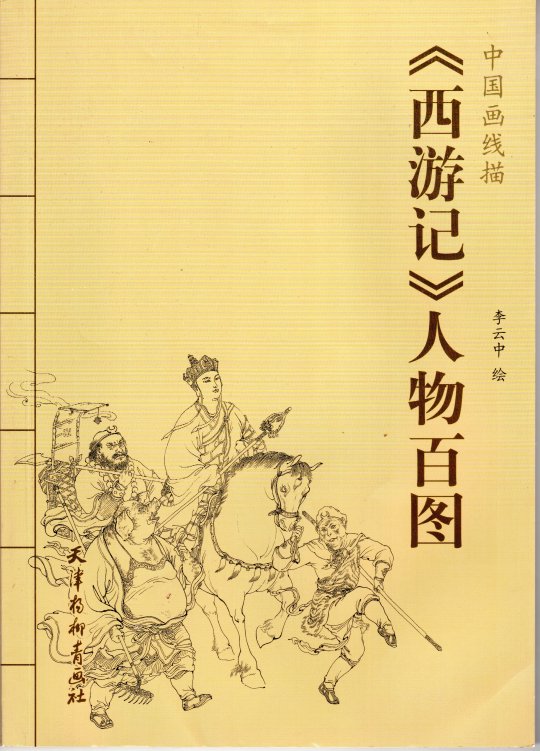
A Journey to the West art book I picked up many years ago at a bookstore in L.A.’s Chinatown. Whenever I had the time I would browse the stacks looking for anything Monkey King related.
The book contains wonderful line drawings of almost every major character from the novel. The artist is Li Yunzhong,

Here is his depiction of Tang Monk, aka Tang Sanzang, aka Tripitaka. I apologize for the bleed-through in the image. The paper in this book is thin pulp, even thinner than old-timey comic books and pulp magazines, and it’s printed on both sides, so the “back” image shows through. I suppose if I got really enterprising I would scan these images into Photoshop and clean them up, but I got exhausted just thinking about that.
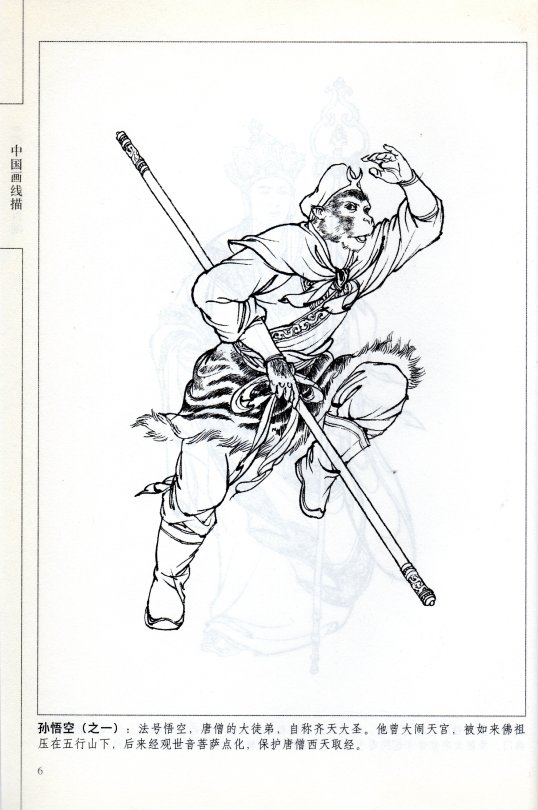
Here’s the real star of JTTW, Monkey King aka Sun Wukong. This design of him very much resembles how he appears in the Shaw Brothers’ film series. I like how the artist has made Monkey King’s kilt a tiger skin, as it is in the novel. The kilt he wears in the films has more of a leopard pattern.
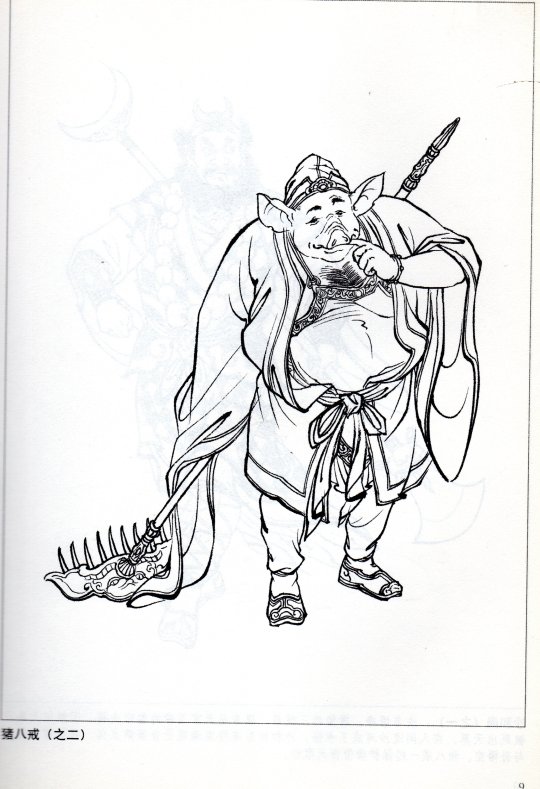
Here’s our ladies’ man of the group, Pigsy aka Zhu Bajie. Very much the comedy relief of our intrepid troupe. I’m kinda glad the artist drew him wearing a shirt under his open robe.
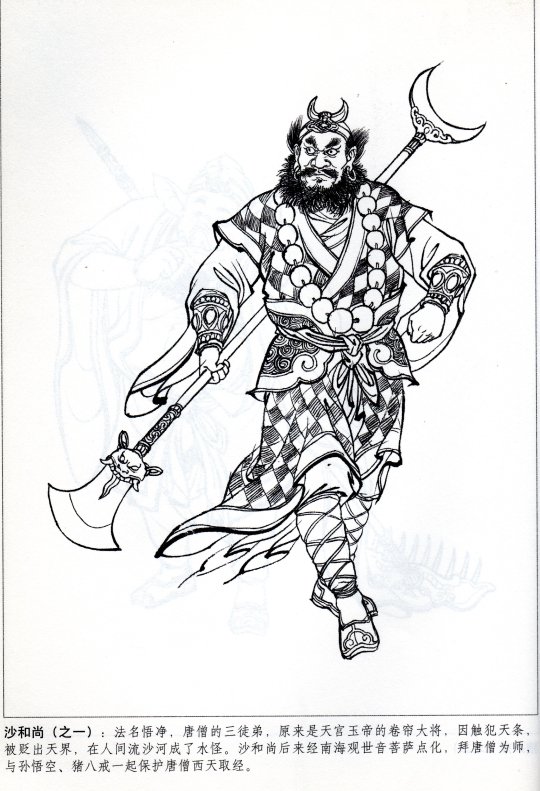
And then we have Sandy, aka Sha Wujing, aka Friar Sand. Where as Monkey King and Pigsy are always either getting into or causing trouble, Sandy does his best to be the “good kid” of the group; the one exasperated parent Tang monk never has to worry about.
#Journey to the West#Tang monk#Tang Sanzang#Monkey King#Sun Wukong#Pigsy#Zhu Bajie#Sandy#Sha Wujing#Li Yunzhong
91 notes
·
View notes
Note
Oh, I have a JTTW AU for you! Behold! Elemental AU! Where everyone controls one of the Five Elements (and the dragon horse’s water control is redundant)! Wukong is metal/fire (not sure about it), Tripitaka is Plant, Bajie is fire/metal (see before) and Sandy has earth! Hilarity ensues!
Alright. So I've seen a few people compare the gang to the five elements before. Wukong and Longma seem to be consistently fire and water respectively, while the rest seem to vary a bit.
Now, full on Elemental AU, there's fun in that.
So I'm guessing Wukong is like almost completely fire and smoke, but still, like, solid?? I mean, monkeys like there physical affection, so I don't think it'd be totally impossible for him to be touched.
So, either he became a fire elemental after being FRICKIN COOKED ALIVE FOR 48 DAYS. Or maybe he was one the moment he exploded from that rock. Like, the rock had a molten core or something.
(omg lava monkey)
Now, Longma I think, as a horse, would look kinda like the water spirit from Frozen 2. Ya know, the water horse thing in the trailer.
(here's where I accidentally posted before I was done.)
Plant Monk. PLANT MONK. YA CAN'T SAY THAT WITHOUT ME IMAGINING MEDITATING SANZANG COVERED IN FLOWERS!!!
He's also probs still human looking. Like, he was the only human in this gang of demons in the book. Maybe the big deal is that he looks so dang human for an Elemental.
I don't have much for a Metal Bajie. Like, he could be a robot or a shiny dude or something.
Wujing now. Him as Earth/Mud. The Friar Sand name is now a bit more fitting. Like, he not only emerged from the river, but STRAIGHT FROM THE MUD OF THE RIVERBED/RIVERBANK. HE COMES OUT LOOKING LIKE THE SWAMP THING.
There's also more to group dynamics based the cycle of, like, strength and weaknesses with the five elements.
Example:
Wood strengths Fire, so here that would be Sanzang helping Wukong be a better person, or his being captured switching Wukong into rescue murder mode.
Fire weakens/restricts Metal. Wukong can beat Bajie in a fight, obviously. Also probably the only thing at least decent at keeping Bajie from overeating and chasing after girls.
Also I'm gonna just keep my tag Happy AU Year for AU talk because I have more AUs and it makes it easier to find all the AU talk on my blog.
16 notes
·
View notes
Text

Wukong, Bajie, and Friar Sand all share one brain cell and it’s very evident in this moment of the story 😭
The Taoist monks asked for holy water and Wukong had the grand idea of filling the jars with urine instead T_T
“Stinking piss” “sound was like that of a torrent” I CANT WITH THE DETAILS😂💀
Then they have the audacity to straighten themselves, act all professional, and tell the monks to come get the “holy water.”😩
I didn’t include the rest but just know the elder Taoist monks ended up drinking the piss and even smacked their lips to taste it better….
(Mind you, all 3 of them did this while Sanzang was sleeping)
26 notes
·
View notes
Note
Hi! You seem to be the JTTW expert and I was wondering if you could clarify something for me; If I understand correctly, Wujing ate 9 of Tripitaka’s previous incarnations, right? If so, shouldn’t he be super-powered by all of them? After all, the reason the demons want to eat him is because Tripitaka cultivated power in his previous lives, which will give them immortality and power. Didn’t that apply to the previous monks?
The 13th-century oral JTTW openly states that Sha Wujing's antecedent has continually eaten Tripitaka:
Deep Sand said: "I am the one who devoured you twice before, monk. Slung from my neck are all your dry bones!" (Wivell, 1994, p. 1190). 深沙云:「項下是和尚兩度被我吃你,袋得枯骨在此。」
And since Tripitaka is the tenth reincarnation of Master Golden Cicada and Sha claims to have eaten nine previous scripture pilgrims (Wu & Yu, 2012, vol. 1, p. 210), it's reasonable to assume that Sha has eaten the monk's past nine lives. However, to my knowledge, JTTW never openly states that the Buddhist master had made previous attempts in his past lives to travel to India, or that he had been eaten by Sha in the process (someone please correct me if I'm wrong).
It's important to remember that Tripitaka, better known as Xuanzang (玄奘, 602-664), is not the only Chinese monk who has traveled to India for scriptures. Another famous scripture pilgrim is Faxian (法顯, 337- c. 422). So, the novel could be referring to other such monks.
But if we were to view the aforementioned nine monks as Tripitaka's past lives, I think the reason why Sha Wujing isn't empowered by their flesh is because their compounding life-long austerities only results in the tenth and final reincarnation being holy.
Fun Fact: The "Deep Sands" demon mentioned above is actually a vilified version of a spirit said to have originally helped Xuanzang in his 7th-century biography. This figure came to be worshiped as Jinja Taishō (深沙大將, “General of the Deep Sands”), a minor protector deity in Japanese Buddhism. One 11th-century Japanese source claims that the General manifested before Faxian in a wrathful form. Most importantly, the skulls around his neck are said to be those of demons, not monks (Dudbridge, 1970, p. 20)!
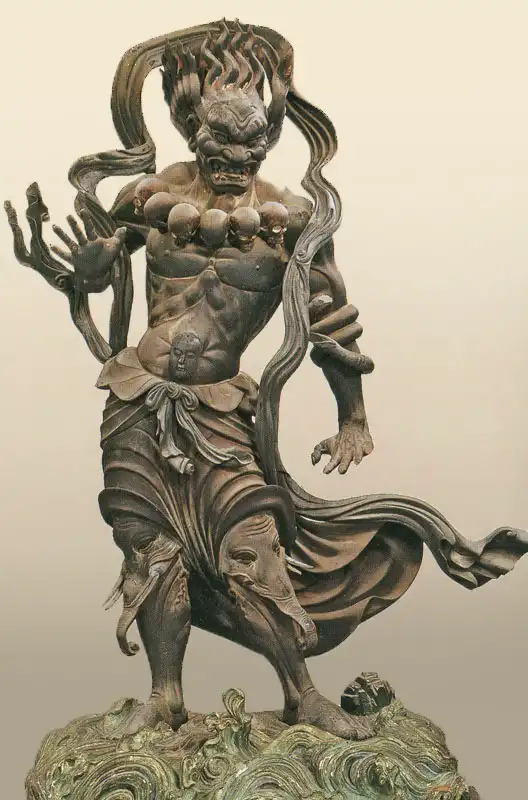
A 13th to 14th-century Japanese Kamakura carving of the General of the Deep Sands.
Sources:
Dudbridge, G. (1970). The Hsi-yu chi: A Study of Antecedents to the Sixteenth-Century Chinese Novel. Cambridge: Cambridge Univ. Press.
Wivell, C.S. (1994). The Story of How the Monk Tripitaka of the Great Country of T’ang Brought Back the Sūtras. In V. Mair (Ed.), The Columbia Anthology of Traditional Chinese Literature (pp. 1181-1207). New York: Columbia University Press.
Wu, C., & Yu, A. C. (2012). The Journey to the West (Vols. 1-4) (Rev. ed.). Chicago, Illinois: University of Chicago Press.
#Sha Wujing#Sandy#Friar Sand#Xuanzang#Tang Monk#Tripitaka#Tang#Journey to the West#JTTW#Lego Monkie Kid#LMK#Sun Wukong#Monkey King#MK
120 notes
·
View notes
Text

The way Sanzang speaks to Wukong sometimes kills me lol. Yet even tho he insults Wukong he still ends up listening to his advice🥹
I think it’s cute how Wukong decided that instead of sleeping (after being awake all night💀) he amuses himself by hopping around the trees😂
Also can we take some time to appreciate Friar sand??? He’s so forgotten 🥲 he’s just a chill guy who usually keeps to himself
23 notes
·
View notes
Text

Friar Sand and Bajie caring for dead Wukong is so endearing to me 🫠🥹 Bajie is usually getting Wukong in trouble or badmouthing him so seeing him bring Wukong back to life lets me know that they truly do have a sincere brotherhood.
Let’s not forget Friar Sand, he’s always been quite respectful and nice to Wukong ;) Friar crying for Wukong is so on brand for him and shows he does have a compassionate soul.
I just felt the need to upload this to show that all three disciples really do care for each other even though they have been through a lot together lol💜
8 notes
·
View notes
Note
The Monkey King's religious given name may have been borrowed from the historical Tuoba monk Wukong (悟空, born 車奉朝, 731-812). And to my knowledge, the full name “Sun Wukong” (孫悟空) appeared as early as the early-Ming JTTW zaju play.
Zhu and Sha also appear in this play, but the former is never called "Wuneng" (悟能), and the latter is never called "Wujing" (悟净). Instead, they are called "Zhu Bajie" (豬八戒) and "Sha heshang" (沙和尚), respectively.
This suggests that the names Wuneng and Wujing were later additions to the story cycle. My educated guess as to why they all have Wu (悟) in their names is that it was done for the sake of symmetry.
There are other examples of symmetry in the novel. For example, the demon kings of the 72 caves match the 72 heavenly commanders. Also, the Bull Demon King's arc is quite similar to that of Monkey. [1]
It's also important to note that Wu (悟) is “one of the common Chinese translations for the Sanskrit term bodhi (awakening)” (Buswell & Lopez, 2014, p. 998). This foreshadows the disciples' eventual enlightenment at the end of novel.
Edit:
The Shaolin Temple uses a poem to name the various disciple cohorts. All disciples in the same cohort have the same generational dharma name (similar to Master Subodhi's students). [2] Lu (2019) explains:

I'm not sure how prevalent this is in other Buddhist institutions, though.
But perhaps the novel is a mix of what Monkey Ruler and I have suggested. As I show above, "Wukong" predates the 1592 JTTW. Guanyin borrowing Wu to name the religious brothers' disciple cohort would not only be symmetrical but follow historical naming conventions.
Note:
He’s an iron staff-wielding demon king nicknamed the “Great Sage,” who knows 72 changes, can adopt a titanic form, takes part in a battle of transformations with an enemy, is trapped by a joint effort from heaven and incapacitated by a circular object, and finally faces the Buddha.
Subodhi's school has 12 generational names used to name students:
1) Guang (廣) 2) Da (大) 3) Zhi (智) 4) Hui (慧) 5) Zhen (真) 6) Ru (如) 7) Xing (性) 8) Hai (海) 9) Ying (穎) 10) Wu (悟) 11) Yuan (圓) 12) Jue (覺) (Wu & Yu, 2012, vol. 1, p. 115).
Source:
Buswell, R. E., & Lopez, D. S. (2014). The Princeton Dictionary of Buddhism. Princeton, NJ: Princeton University Press.
Lu, Z. (2019). A History of Shaolin: Buddhism, Kung Fu and Identity. United Kingdom: Taylor & Francis.
Is there a tradition that explains why all 3 disciples have religious names that start with Wù?
I'm actually not too sure myself in details but what I can tell you that when it comes to religious names whether that be for Taoism or Buddhism it was a practice to get a name for while you are a disciple or even continue with the faith. Usually you keep your surname and have a new given name with the first character being the generation of disciples you are training with, showing that you are all of the same “class” so to speak. These are what are considered your ‘sisters’ or ‘brothers’ in cultivation. And the second character is that of another given character to make each name unique. I can’t say for sure how this process goes as from most of my religious studies this tradition is rarely touched on and I could be missing information about this practice due to that.


Religious names are more to represent the sect that one has entered. Wukong got his religious name when he entered Putis school and he was given his name from the listings of characters provided. This would make it so that there are many other dispels alongside Wukong that have the 悟 character as well in their name. But he has also listed the other sect names that each generation in his school has gone through as well.
My best guess is that GuanYin actually had it that Bajie and Wujing would share their names with Wukong. She always planned to have it that Wukong would join the journey but made sure that Wujing and Bajie would be considered Wukongs fellow disciples because of their shared name. Which I find it very sweet that she could have thought about having Bajie and Wujing follow Wukong's lead in order to show they are a team untie together.
#Sun Wukong#Monkey King#Zhu Bajie#Zhu Wuneng#Pigsy#Sha Wujing#Sha Monk#Friar Sand#Sandy#Journey to the West#JTTW#Lego Monkie Kid#LMK#MK
44 notes
·
View notes
Note
WHAT ABOUT SHA WUJING???
Fish man needs love
HELL YEAH HE DOES!!!
Honestly while I know Sha Wujing's much more "passive" in the story than Sun Wukong or Zhu Bajie, the more I learn about his story & role the more I like him. Besides him toting the luggage, his often-given role of peacemaker among the pilgrims is an important one, and tbh his history pre-journey of being another military deity with the rank of general before being exiled to Earth and stabbed like a bazillion times for breaking a vase (which apparently has some really fascinating implication on account of that having the historical precedent of being the signal to start a coup), NOT TO MENTION LIKELY BEING THE YAOGUAI WHO ATE ALL NINE OF GOLDEN CICADA'S INCARNATIONS UNTIL TANG SANZANG, does suggest a pretty violent and really interesting contrast to his usual place during the journey itself. I genuinely think there's a lot that could be done in retellings with everyone's favorite Friar Sand, and he's definitely a figure that deserves love and attention in jttw-based works.
Also personal headcanon but I like to think he's even more of a double triple quadruple immortal than Sun Wukong on account of all the holy monks he devoured. If but one piece of Tang Sanzang's flesh could grant someone immortality, then imagine what eating an entire nine of him could do <3.
#xiyouji#journey to the west#jttw#sha wujing#so yeah in conclusion this guy has a lot going on#much of it pretty violent#that definitely should be explored#especially given how much he seems to often be depicted as the most peaceful of the yaoguai pilgrims#also I'd love to see a conversation between him and the monkey king about how they became so immortal#thieving vegetarian route vs. violent cannibal route lmao#anon answered
42 notes
·
View notes
Text
The Origin of Sandy from Lego Monkie Kid

Many readers will be surprised to learn that Sandy (fig. 1) has the longest association with the Journey to the West story cycle, predating Sun Wukong (c. 1000) and Zhu Bajie (14th-century) by centuries. He can be traced to an obscure desert spirit mentioned in an embellished 7th-century biography of the historical monk Xuanzang (a.k.a. Tang Sanzang; a.k.a. Mr. Tang). The spirit is said to have helped him find water after the cleric spilled his supply while traveling through the "Moving Sands", a harsh desert in the northwest of China. It's interesting to note that the spirit was eventually equated with a Buddhist deity and came to be worshiped in Japan as the "General of the Deep Sands" (Jinja Taishō, 深沙大將) (fig. 2), a minor Buddhist guardian spirit. Japanese material describes him as a seemingly frightening creature with a bloody mouth, a necklace of skulls, serpent-wrapped arms, and demonic knees.

The spirit was eventually remolded as a monster, as evidence by his appearance as a villain in the 13th-century version of the story cycle. He claims to have eaten Xuanzang's two previous incarnations when they attempted to obtain the scriptures in the past. But he is eventually defeated and helps the monk cross a river with a magic golden bridge. This monster eventually became the antagonist-turned-protagonist Sha Wujing in the 1592 version of Journey to the West (fig. 3). For more info, see my article on the subject.

Now a note on Sandy's weapon. Those who have seen Lego Monkie Kid will know that he uses a large, chunky "crescent staff". This is commonly referred to as a "Monk's spade" in martial culture. But while weapons featuring the crescent do date to the Ming, the Monk's spade is believed to be a 20th-century weapon. Most importantly, the 1592 edition of the novel mentions that Sha Wujing actually uses a wooden, pearl-covered staff. See my other article for more info.
56 notes
·
View notes
Note
hey your blog is pretty neat! thanks for the jjtw pdf link too, i found a pdf online that was a lot less well-translated than yours :)
Thank you for the kind words. I’m happy you like my work. I know there are different PDFs floating around. You may have found a “retelling” from some random person. The first edition that I ever read was the W. J. F. Jenner translation. While less accurate and lacking the copious footnotes of the Anthony C. Yu 2012 revised version, I personally think it’s more fun to read. Yu’s rendering is often dry. Plus, there are great Qing-era woodblock prints to illustrate the various characters and episodes.


#Sun Wukong#Monkey King#Journey to the West#Journey to the West translation#JTTW#Lego Monkie Kid#Anthony C. Yu#W. J. F. Jenner#translation#Tripitaka#Tang Monk#Tang Sanzang#Zhu Bajie#Zhu Wuneng#Pigsy#Sha Wujing#Sha Monk#Friar Sand
58 notes
·
View notes
Photo
I think in JttW he is Friar Sand.






NOT!Anatomy but still interesting.
I took this picture in Beijing last week, and posted it to my FB, asking followers to guess what the stick the cop was holding, was for.
One person got it right.
4K notes
·
View notes